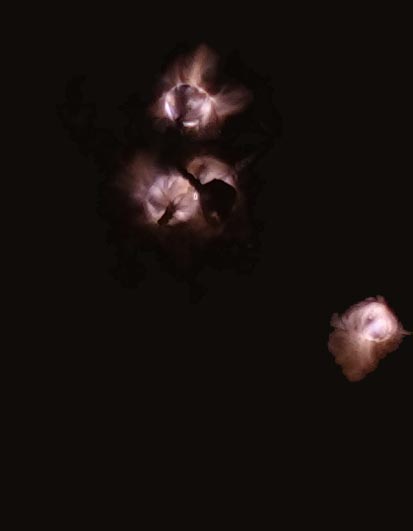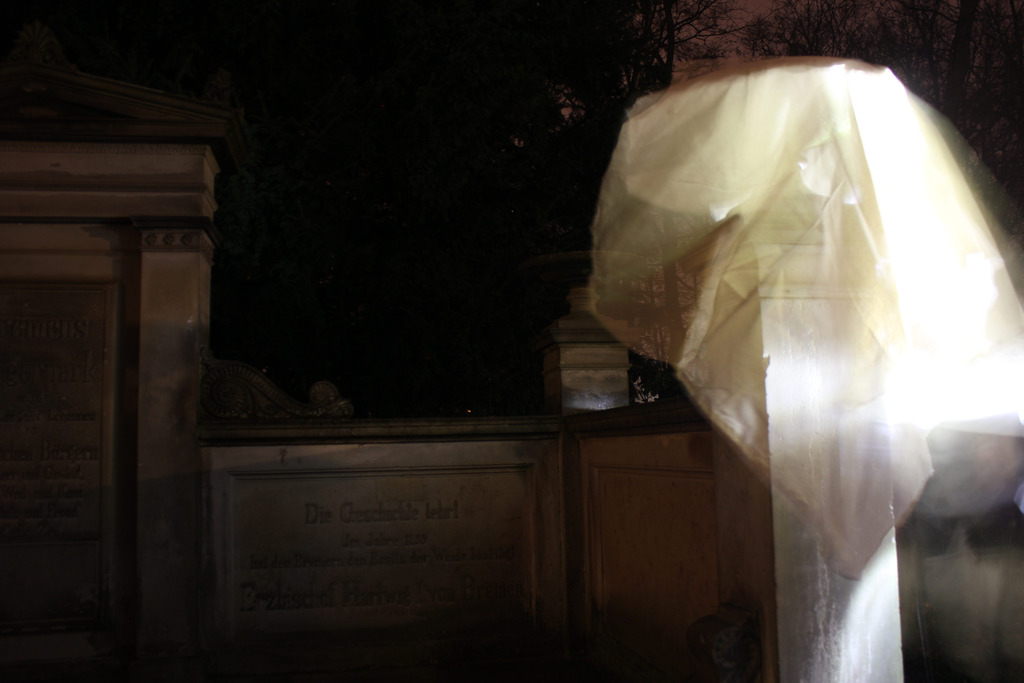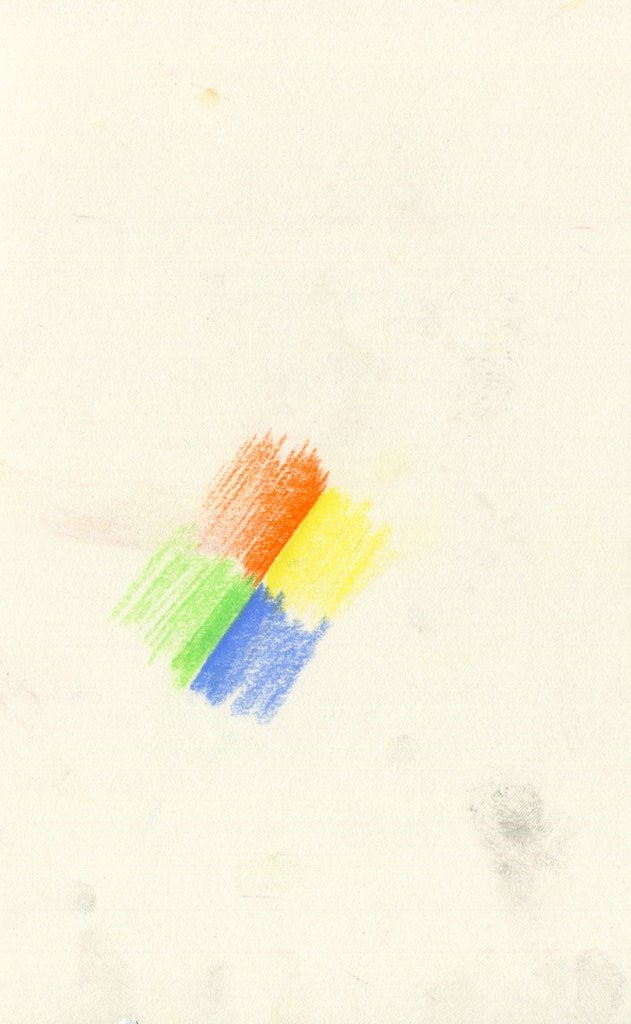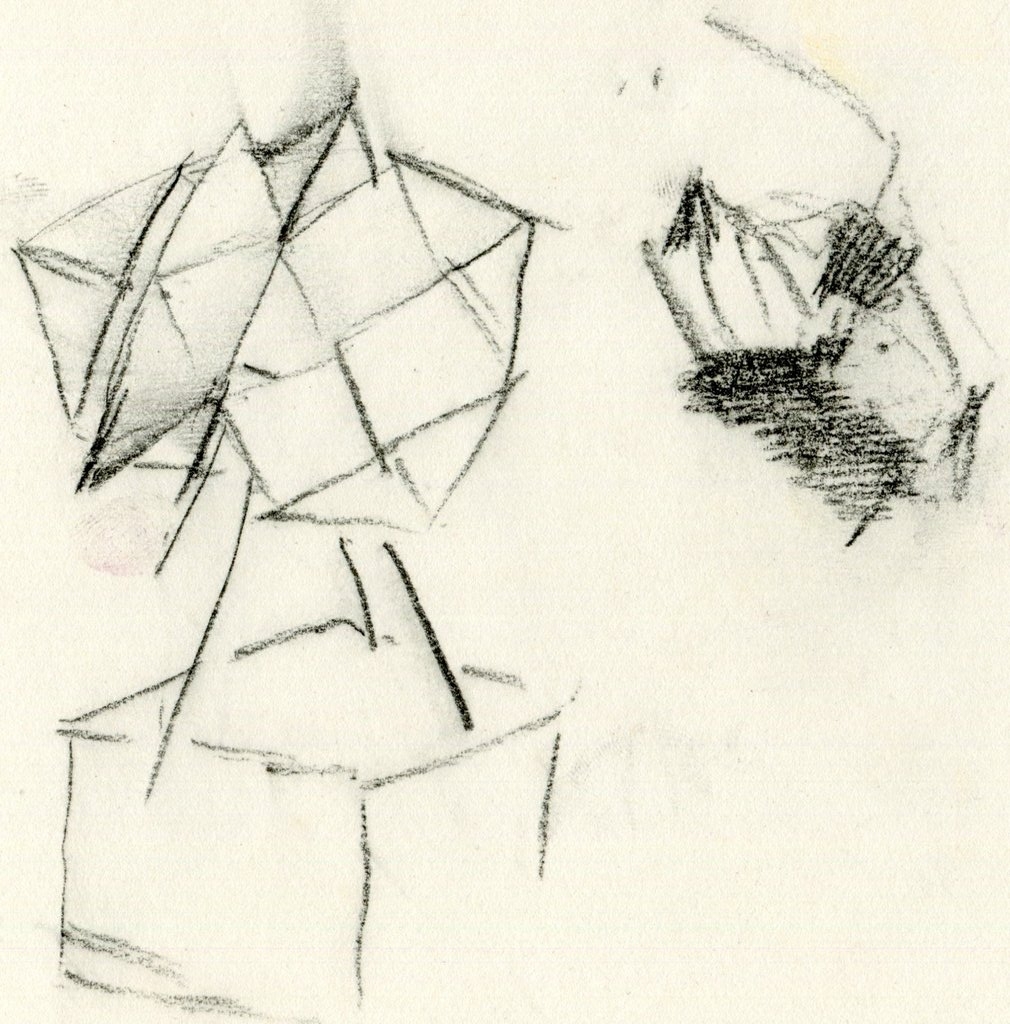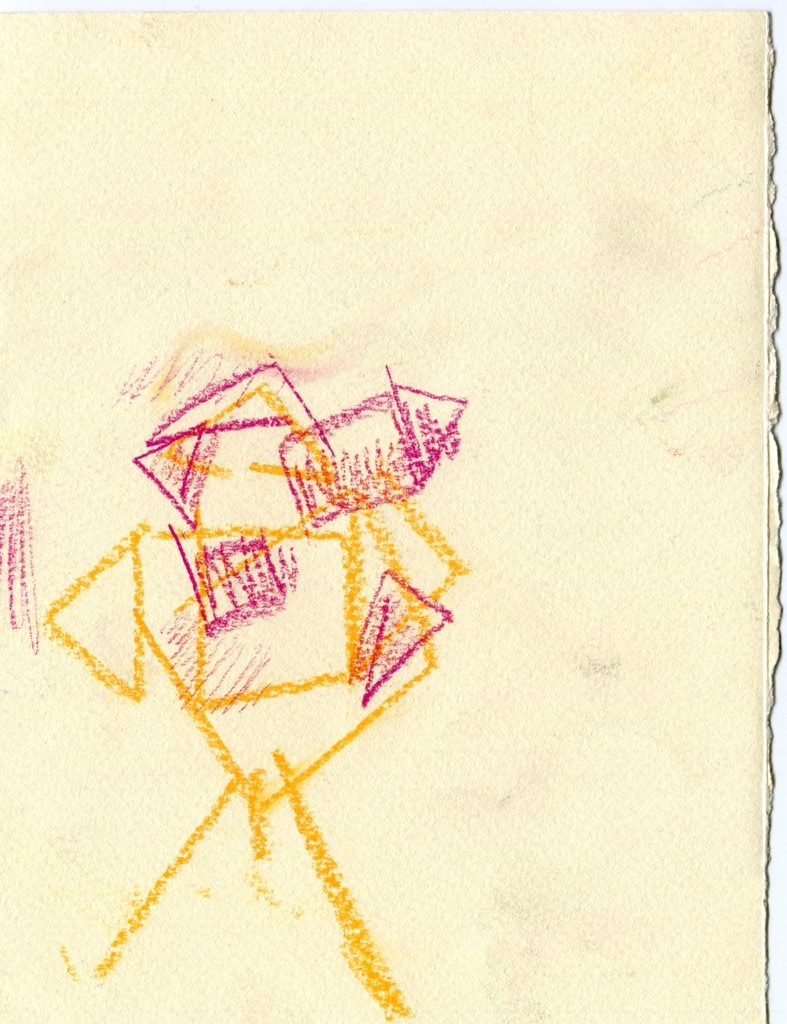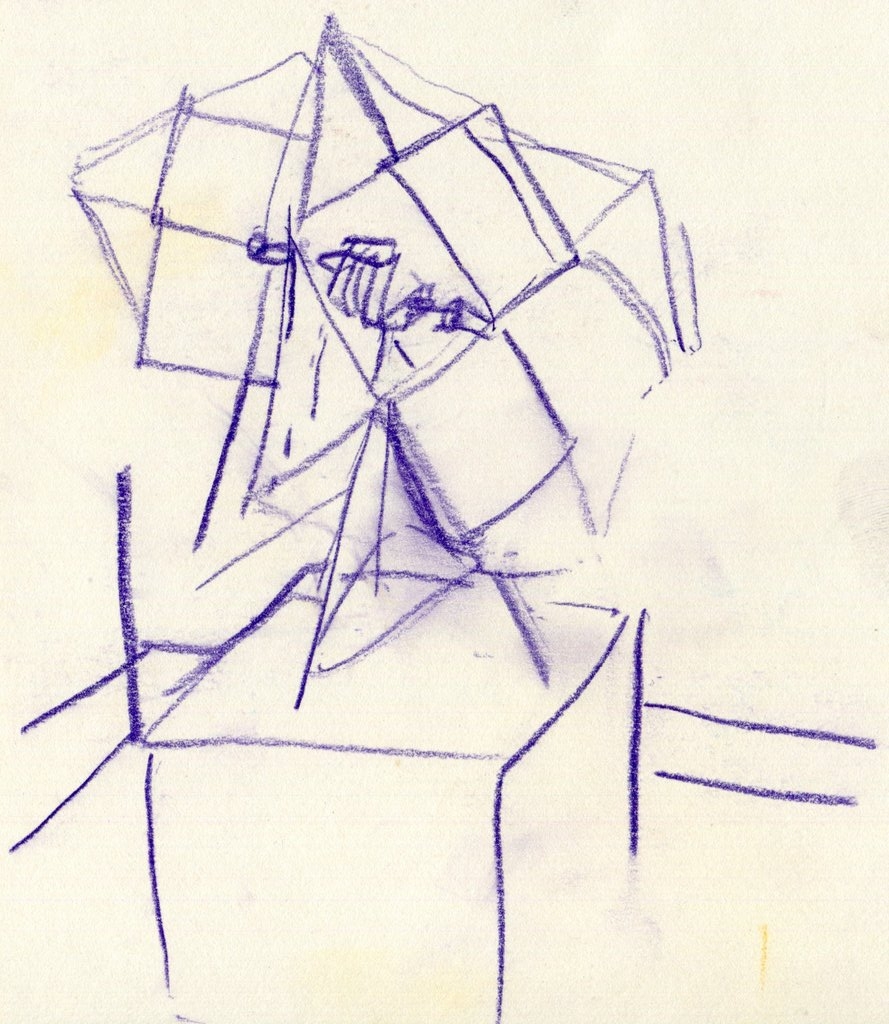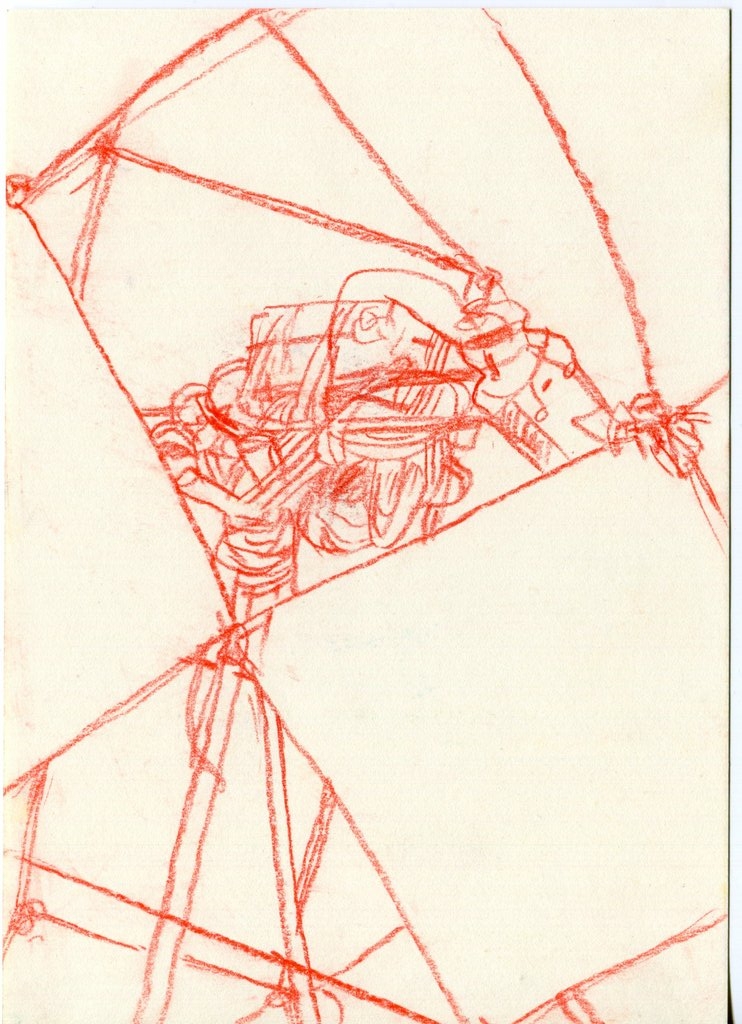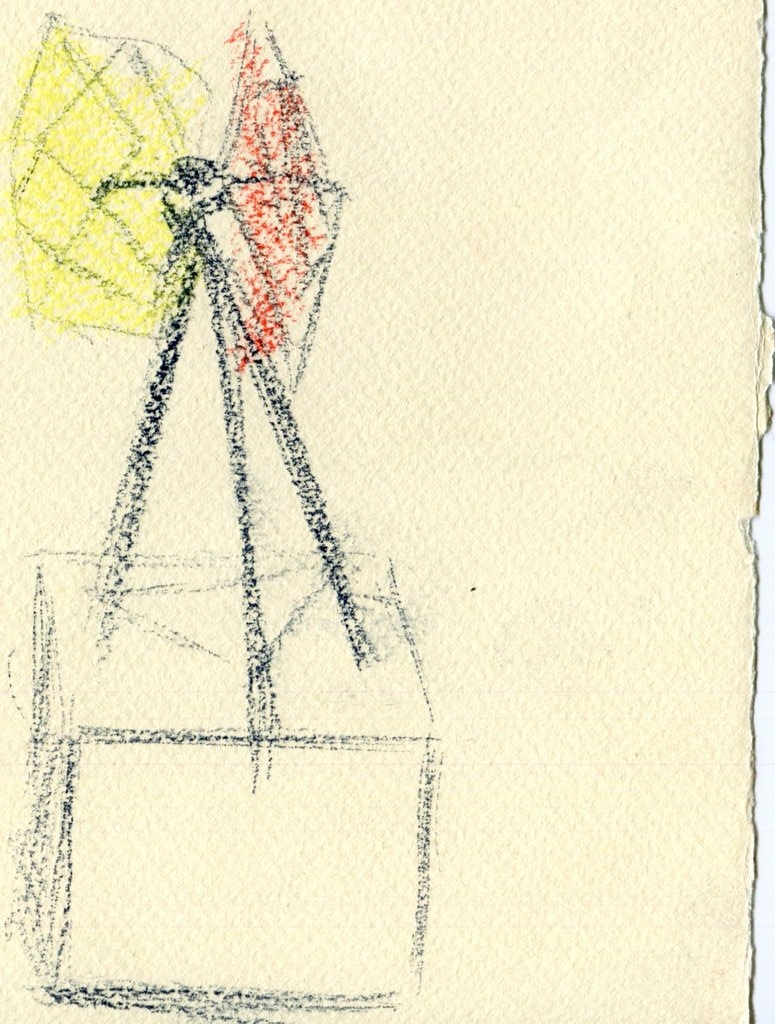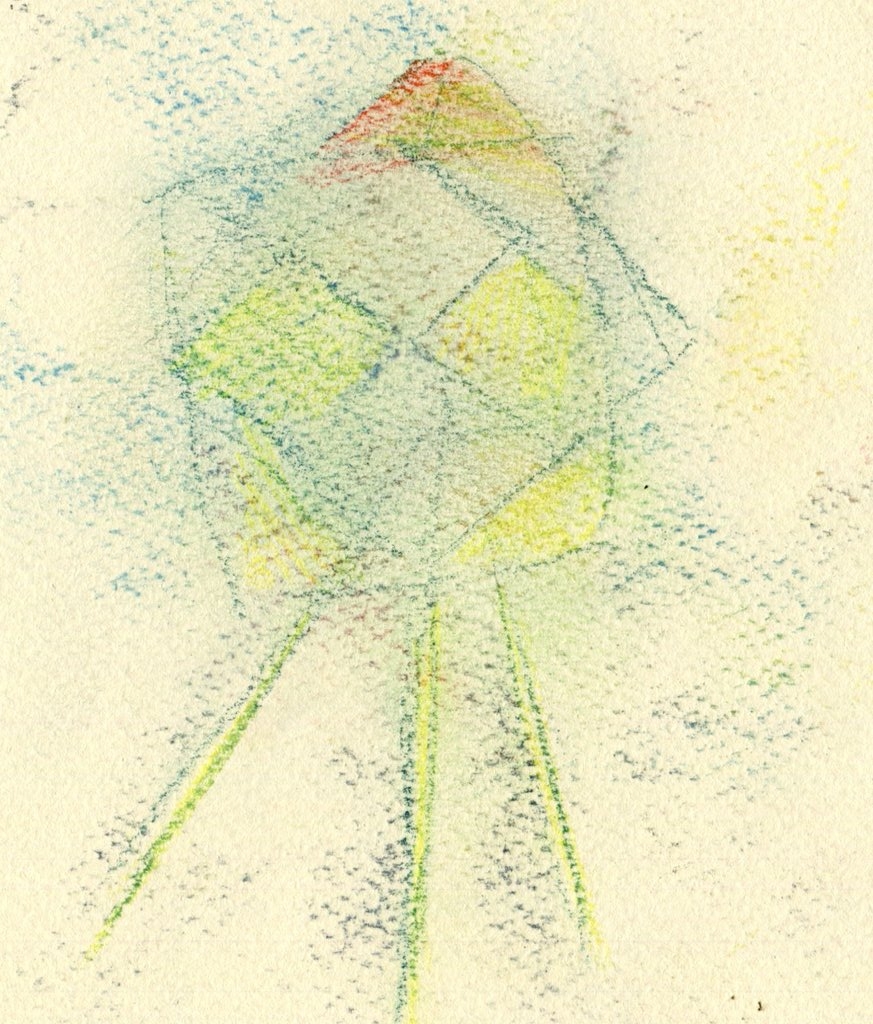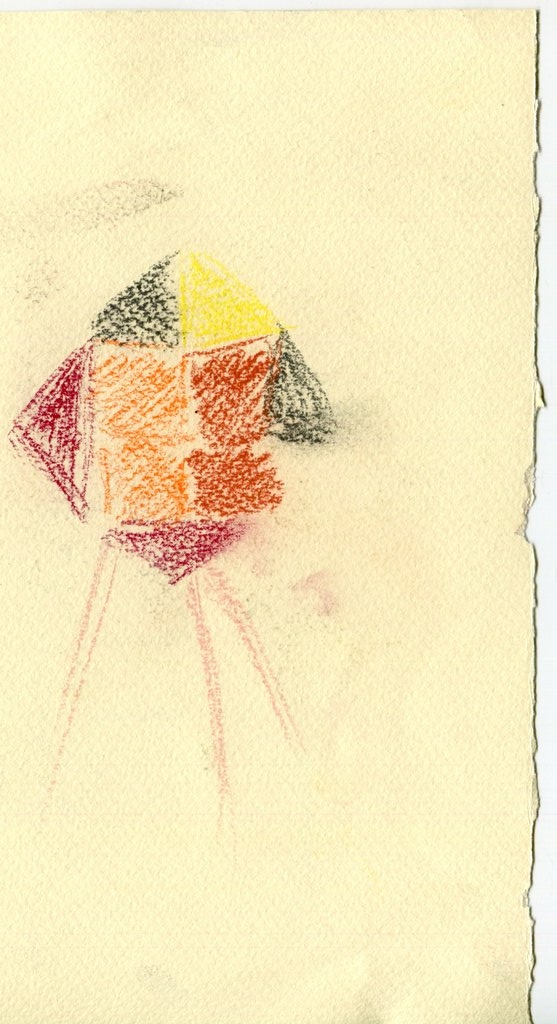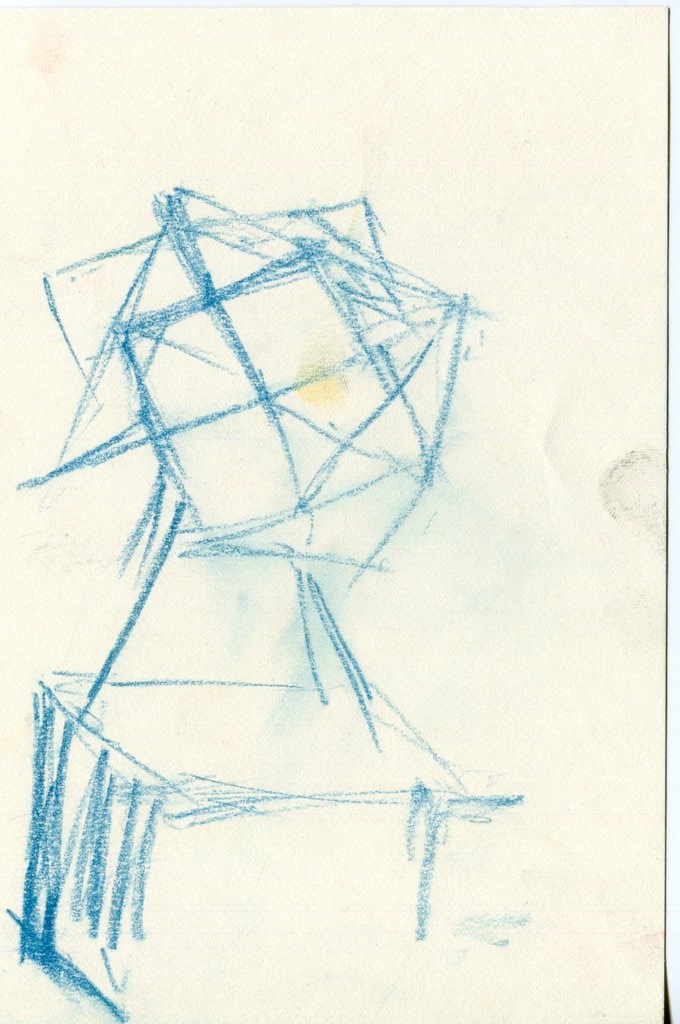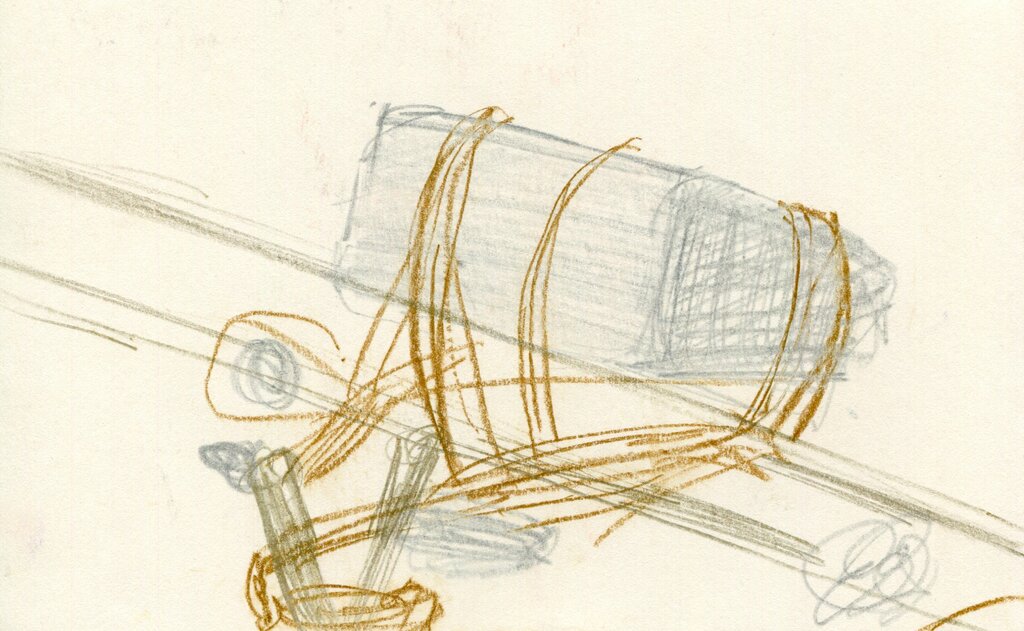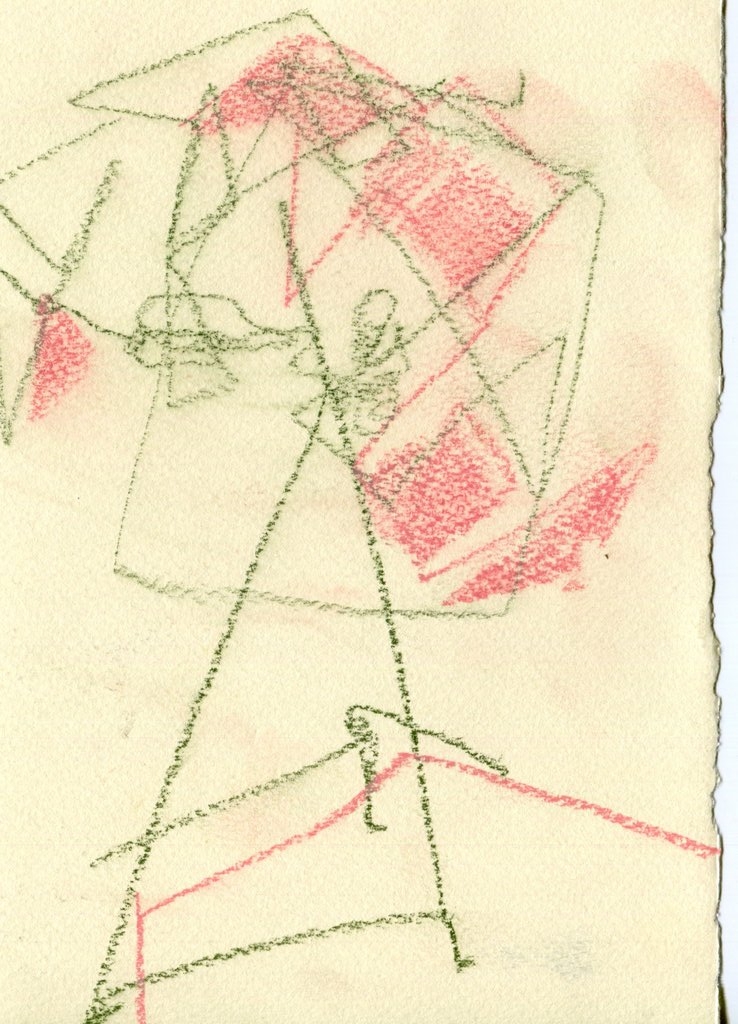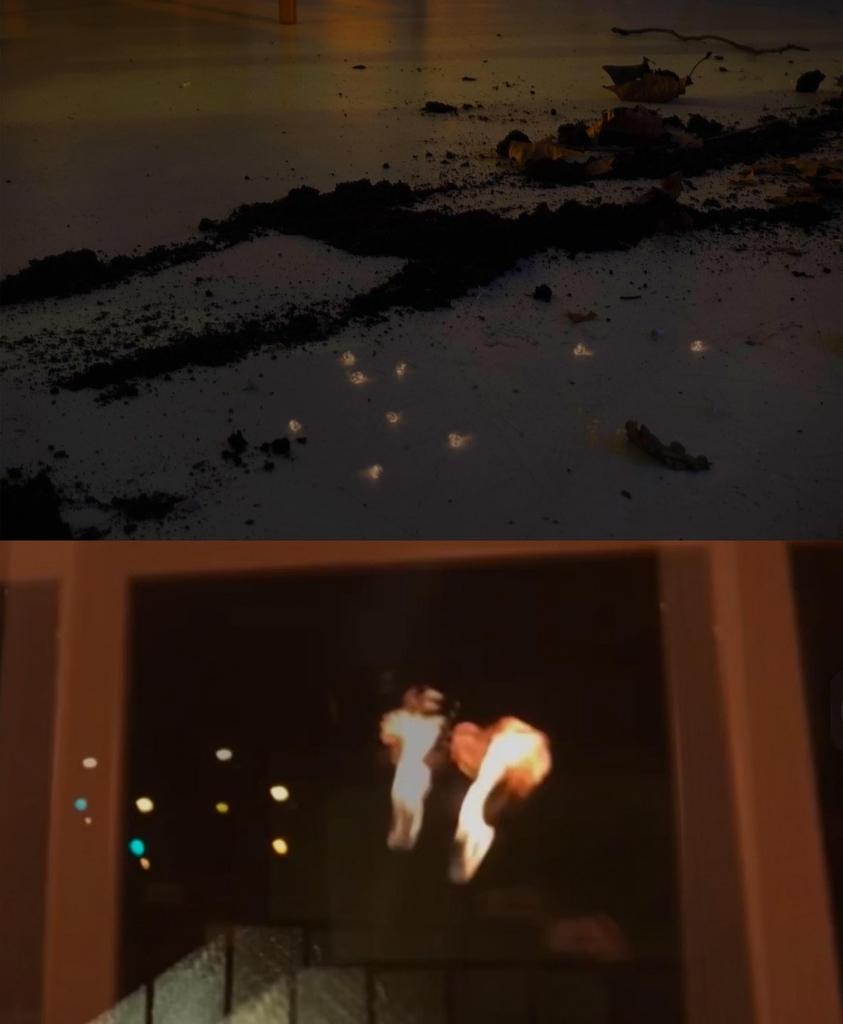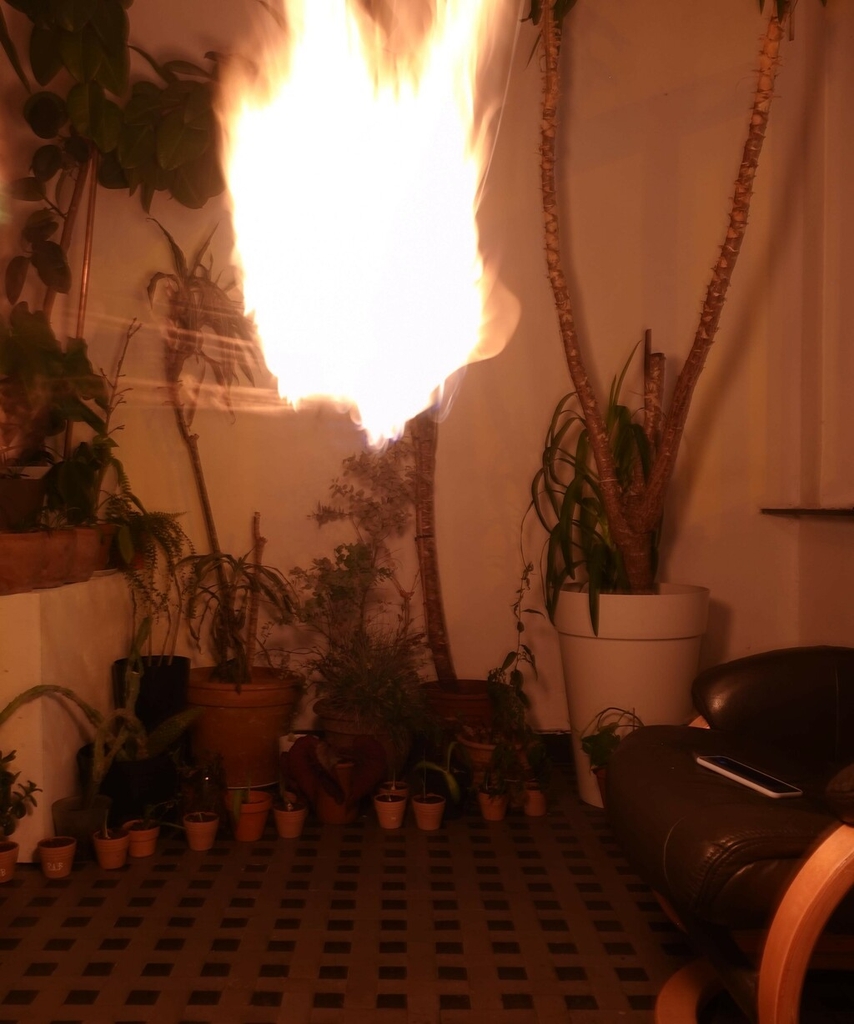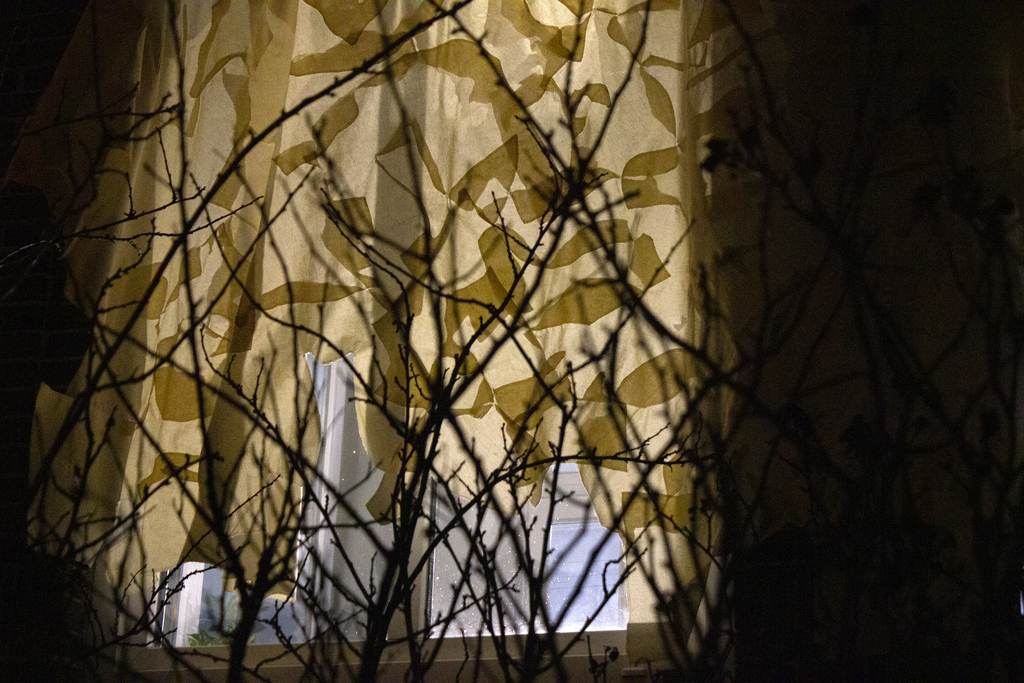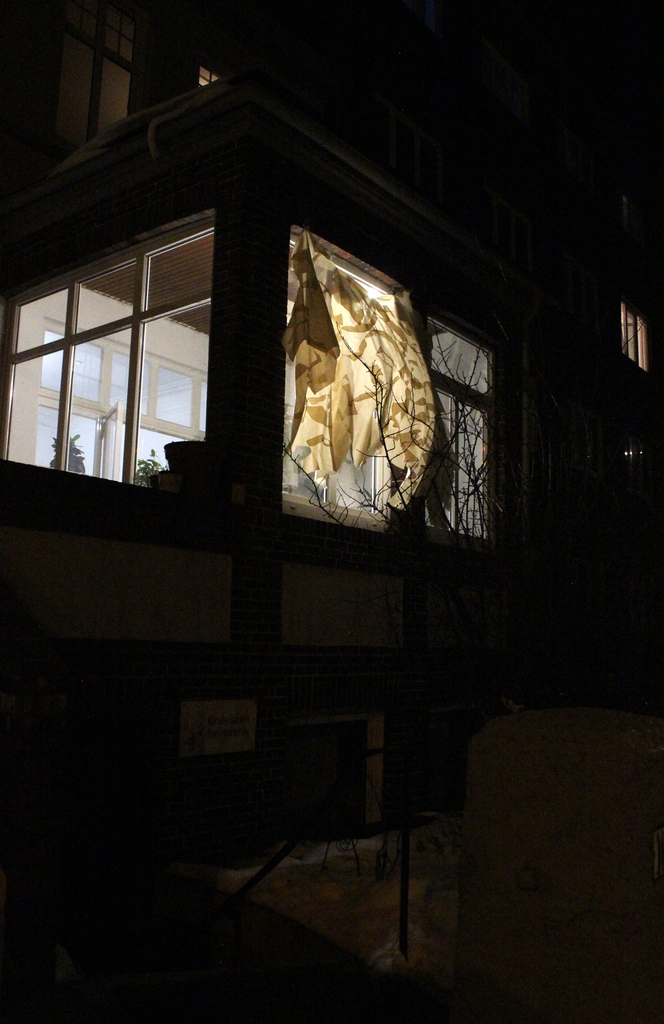Shape Shifting | Sightings at circa 106
Lucas Odahara in conversation with Antonio Hofmeister Ribeiro, Rahel Jüngling, Rogerio Nishizawa, Hanna Stijnen, Karina Burjakov, Ziyi Li, Victor Artiga Rodriguez and Aria Farajnezhad.
* To navigate the documentation choose a date in the calendar on the bottom right corner. Click or tap the images to make them dissapear. Videos will dissapear by themselves after they finish. Hover or tap on top of the text to bring it to the front.
Lucas
We all first met on screen. Looking back, it happened exactly on the Day of the Dead, All Soul’s Day, Samhain. And under this omen, as stranded bodies at home and tired sights from screen fatigue, we pushed ourselves a step further from the changes already required by the pandemic. We moved outside the university’s building and took our weary sights towards the questionably visible. And through these rehearsals of uncertain movements we encountered other things. Things that few or none saw, whose corporeality are not taken for granted but which we welcomed in attempting to recognise it in relation to our own body – a body that has also lost visibility over the past year. And like most of the things that shape us, these encounters materialised unannounced. They happened and we witnessed them. The more they happened we learned how to react, to shift our understanding of making work, of public and private, of the intentions of a story, all in order to find the best way to see them, to train our response-abilities (Haraway). Fatigued but not still. In fact, alert.The week between the 9 and the 17th of February was unusual, even in face of the already unusual (to say the least) past 12 months. Bremen, just like other cities in the north of Germany was hit by a snow blizzard and very low temperatures, something we haven’t seen in the past winters. It was also during this week that unannounced things took place at Circa 106, at night, out of most people’s sights. In fact, sight, visibility, the shape of things and its mutabilities were some of the things that we (Antonio, Rahel, Rogerio, Hanna, Karina, Ziyi and myself) have been talking about throughout the past months in our weekly meetings.
We have called these unannounced encounters outside the university as sightings, and they first took place at the Bürgerpark in our night walks after online screen hours. So maybe we can start by talking about these first sightings at the park?
Rahel
Yes, as you mentioned, the starting point was the screen from our private rooms, safely inside of our four walls. Then we met a few times, before the lockdown got more strict, at the HfK, another kind of inside. And it was after these meetings that we decided to go to the Bürgerpark, outside. All these separate places, decentralizing the university as an institution, makes me question my own understanding of an art university, which in these days doesn’t really exist, as everything is happening outside of it.At the park as a group, each one of us brought some objects to our first rehearsals. Meeting in person is so rare these days but still so important to get to know each other, so these materialized objects and happenings spoke 1000 words more than just a photo on the screen. The Bürgerpark is a public space in the city which allows its citizens to perceive the wilderness of a forest, and that’s where we gathered. But like every public area, there are also many restrictions in place. In our first meeting there, just ten minutes after we entered the park, we got asked by a park ranger if we were planning something, like a demonstration (perhaps we looked like this?!) and that if we were, it had to be first approved by the authorities. It was a similar feeling from being currently at our art university, where even entering it also needs to be approved by the authorities.
Lucas
That’s right. The idea of sight and presence in different spaces was a recurrent topic for us. Which led to the decision of meeting at the park only after sunset. I also remember that you specifically noticed some monuments at the park. Can you maybe talk a bit about that?Rahel
Yes, ‘seeing’ in the park had so many aspects: Seeing the other classmates, seeing this public space differently as searching for spots where we could place what we brought, and seeing in the dark nights surrounded by trees is different: everything which is bright and has light has so much power in visibility. Once there, I also explored the space more and found a lot of monuments, which I hadn’t noticed before. What exactly do they stand for and who needs these monuments? I covered some of them with fabric and took photos. It became something completely different. Something abstract. It was like making this ‘abstraction’ visible. Covering itself is already an act of questioning. Making art during the pandemic feels for me like hiding behind a big piece of fabric.Lucas
> Hanna, in terms of seeing in the dark, as Rahel described, I remember you tried to capture the things we experienced through photography. Could you maybe describe the role that the camera has in seeing, in registering something even beyond sight?Hanna
In a way, I would describe seeing as visually perceiving moments, one at a time. Nowadays, cameras are able to capture even moments as short as a fragment of a second, making visible parts of movements which we are not usually able to perceive in real life. Likewise, if we think the other way around, like in the beginnings of photography, and look at much longer exposure times, it is also possible to use movement to create new shapes only visible in the photograph.Lucas
Like if the movement of a camera’s shutter could render images that go beyond the ‘unquestionable reality’. Could you maybe give an example of how that happened in the beginnings of photography?Hanna
Photography could indeed even create another, a ‘questionable reality’ or at least provoke thoughts about what might be ‘real’. In the case of long exposure it is the aspect of time which is responsible for the manifestation of different parts of a movement in one photograph. In the beginnings of photography this effect was used to create appearances of ghosts. Since the film in the camera needed a lot of light to imprint what was in front of the lens it was necessary to expose it to light for a long time, which resulted in a transparent body should a person leave their place during the exposure. The topic of this so-called “spirit photography” was taken seriously and research regarding its truthfulness on capturing ghosts was carried out starting in the late nineteenth century.Lucas
Rogerio, in your case, I think the word sighting needs actually to go really beyond sight, that is, outside of vision, as you encountered sounds. Can you describe a bit what these first sounds at the park were like?Rogerio
In the park I was wondering how one can express changes of forms, without looking specifically at the format itself. And I believe that one of the things that can most easily change its form is sound. I tried to look for memories of indigenous rituals, songs of Santo Daime linked to ayahuasca, sound recordings of Afro-Brazilian candomble, preaches by evangelical pastors churches from remote cities, and the wind.All of this was mixed-in as a background soundscape where the forest and weather alterations interact. The most magical thing was to realize how much that new sound environment interacted with other works that were present at the same time.
Lucas
Karina, there was this one evening at the park that was very memorable. The park was full, there had been the attempt of a protest against corona measures that was forbidden by the government. All the stranded protesters decided to spread in the park, where we were. I remember this evening almost like a dream. The fog, the police cars, the fear of being mistaken by something else. Can you maybe describe what happened that evening?Karina
Yes, I think it was the second rehearsal we did in the Bürgerpark. I felt really weird when I entered the park because there were so many police cars outside and also inside patrolling. They were going around, checking for people who were trying to attempt the forbidden protest. I was really worried to be mistaken for a protester but was at the same time suspicious towards the other people walking in the park trying to guess whether they were part of the protest or not. The park as an open space for everybody to walk freely, and for us in particular a place for playful exploration, suddenly turned into a monitoring situation and thereby a constricting experience. I guess our rehearsal always made some people look but in that situation the attracted gaze felt more violent and uncomfortable and our own bodies became the sighting itself.Lucas
Ziyi, you made an interesting photo of this evening of the police. Which reminds me of another photo you took in the park, that you named I believe as firecrackers, and also of a short video of moths. Can you maybe speak a little about these three elements – police car lights, firecrackers and moths in the park, and why were you interested in them?Ziyi
Okay, let's go back in time! This evening with the police cars, I felt bad at first. As Karina said, that night our group overlapped with the protesters. But then I started to feel funny. We were like undercover agents, like Mission Impossible. We got separated as a group, the police cars had been patrolling the whole time, and I didn't want to be caught in the police lights, so I kept hiding, and that’s when I met the moths. I was actually like the moths in the woods, they would fly away when they were caught in the light of my flashlight – an instinctive avoidance? Just like an ecological chain. These moths made me feel like I was disappearing from the world I live in everyday. Also, the moths were the second creature I saw that night besides humans. They were hiding in the dark.As for the fire, in many cultures fire can drive out demons and protect humans and bring them a sense of security, while also reminding me of war and crisis. In the firecrackers photo, what I have captured is only the visible portion of the fire, the flame. For the fire, if hot enough, the gases from fire may become ionized to produce plasma. And the flame shape will also be affected by gravity. So in a way, the fire will always be deformed by the changes in the environment it is in. That’s where I believe the firecrackers come up in these photographs at the park.
Lucas
So there’s an interconnectedness between these elements and the space they find themselves in. Your description of the fire makes me think that one cannot even think of the fire as an individual shape, but rather as something in constant negotiation with everything else around it. Which is interesting, considering that in your photos, no visible human form interacts with these elements. Almost as if they happen even if there would be no one around to see them. Is that so?Ziyi
Yes. Through photography, I was experimenting with something that was already there. I remember from one of our earlier conversations, Rogerio talking about his experience with an ancient sprite in the rainforest. In his account, he and the group he was with, had not seen the sprite and could not identify its form. But they were certain that it did happen, as they all witnessed it.Besides that, I think about the picture you took of me on our first evening at the park, where I am waving pieces of paper by moving my body. It was a refreshing experience for me during the long lockdown. But as I looked at the photo, I couldn't understand the image of myself in it. I didn't know what to do with my body. So after that I kept thinking about whether to hide myself. What state was my body in? That's why I try to make photos by putting aside the first and third viewer perspective.
Lucas
Antonio, can you maybe describe the first time we were at the park? The kite? The Odradek? Was that maybe actually the first sighting you had of the Odradek, which reappeared at Circa a few months later? If so, can you maybe tell us a bit what the Odradek is?Antonio
I guess it was, on a subconscious level. I remember it was a bright night, with a half-moon lurking behind the trees. When you asked us to bring an object to the park, I immediately thought of making a kite. The space behind the park hotel is pretty open and it is perfect to fly a kite. The reflections of the moon light on the kite's material that night left quite an impression on me, and I guess on others as well. The kite's material was transparent, but not quite totally, it seemed to disappear at times, then we would see it again, in another part of the sky. The idea of shape-shifting, of transforming your own work - or self - to fit an unexpected situation, was such an inspiration for us. In the end, we had to shape-shift twice. At first, to come up with something to experiment outside. Then, we moved to a private sphere, on Circa. That's when the Odradek came to me, quite suddenly. I remember reading about it briefly in Borges book of imaginary beings. In a nutshell, it's this mysterious and impossible creature that appears in one of Kafka's short stories ("Die Sorge des Hausvaters), visiting a house of a family man. As I revisited the text, I realized the Odradek is made of the same materials of a kite: wooden rods and threads, entangled in each other. It's shape is quite uncanny and difficult to grasp. As the protagonist analizes it further, his description also changes. So quintessentially, the Odradek is always shape-shifting. I think it's the materialization of our core concept. Here is a quote from Ian Fleishman paper "The Rustle of the Anthropocene: Kafka's Odradek as Ecocritical Icon":"Franz Kafka’s Odradek is one of many barely detectable shapes that inhabit the Earth with us. These shapes largely exceed, underwhelm, or otherwise elide our notice: they are too vague or sharp, or too fast or slow, and their murmurings are too smooth or intermittent for the human sensorium. They are real, but not always fully actual. They exist as ``‘hyper-objects’`` These forms are almost too different from us to matter: almost, because now and then encounters happen and we receive hints of their presence.``They haunt ‘our’ world"
Lucas
It’s interesting how you bring the story of the Odradek and its impossibility to be ‘really seen’ due to its shifting aspect, especially when we think of it as a kite, moving outdoors. In fact, the movement of our own bodies between inside and outside during the past months and all the shifting that happened in between was a central element in how we understood the things in front of us. The decision of bringing these sightings to Circa 106 happened after a few discussions between us and Aria and Victor, who also thought that Circa 106 often navigates between these terms. Would you like to say something about that, Aria? I felt like in our meetings there was a sense of Circa 106 being also in this shifting state, that is, at times it is an exhibition space, then becomes part of the body of the HfK, then a WG, and all this mutations was even heightened since the first lockdown. How would you say that these different forms of Circa take place?Aria
yeah thank you Lucas for mentioning this, I also can remember the fruitful conversation we had around these correspondences. Circa 106’s first and oddly last physical exhibition was called “how to situate spaces of uncertainty” which happened in March 2020, and I wonder if we did ever fully situate this shape-shifting precarity. However, I think it is interesting to look at the very particular space Circa 106 is dwelling, oscillating not only between personalities but also legal and administrative frameworks. I remember once Andrea Sick for the sake of clarification told us to think about the space as a so-called added “Segment” to the HFK building, as if the project space is an extended organ, a teleported compartment, grew out of the inner city. So being in and out of the institution gives one the possibility to be affiliated but also holding a degree of autonomy. a place that could perform beyond the convention of a gallery space in the art school.Lucas
This idea of an extended organ makes me think of a phantom limb in the lockdown context. The feeling of a presence that is not there anymore. Which is somehow what happened in these sightings, I think. Circa has been closed since the second lockdown started in Bremen, and thinking of it as an empty, partially uninhabited house, made us think of all the things that could happen there without an audience, like apparitions. Apparitions do not announce themselves beforehand, they don’t make invitations or events, but just happen, at times being spotted by someone else. How to talk about something that you experienced, but not other people did, is something that has been so present in the past year. Can you maybe tell us how was it for you to be part of these sightings, that is, to witness something happening in your temporarily closed space, without other viewers, and thinking of how to talk to people about that after, how to make people ‘believe’?Victor
When thinking about your question I felt a particular magnetism to the word “believe”. As you pointed out, what we believe or not, has somehow undergone a transformation during these times of the pandemic. Who would’ve believed such a substantial change to our daily routine would endure for such a long period of time? Artistic production in itself could be understood as a belief system. One where we are continually confronted in a game of believing whether the role of institutions, museums, art schools, galleries, project spaces etc. are to be trusted. Certainly, these pockets of trust vary in their intentionality and degree of empathy, and perhaps here is where the word “trust” comes into play. I do wonder how interconnected and how contrasting are the words “trust” and “believe”. I guess for us, we dived into a game of trust with the discussions you had been developing throughout the period of the course, and finally ended up “believing” all the sightings that took place at Circa. At the end, I think that the “sightings” that happened at Circa dwell in a delicate narrative space of mystery and trust, for the viewers, for the house and for us.Lucas
That’s beautiful. ‘Believe’ is definitely something we’ve been dealing with in the past months as a group. Working with a group of artists that should be making work at the HfK, I felt like there is another kind of belief in play today, which is related to a question, or actually a vent, that was raised at the very beginning of our meetings: if we make work and no one sees it, what’s the point? This stuck with me, as it is not only about having exhibitions or the usual institutional approval of visibility, but literally about seeing. Sharing your work at plenums at school, having people pass by at the studio, looking at something being made at the workshops. The screen knows no gaze, you can never tell what one is looking at, and one of the ways we decided to deal with this was by bringing the question of the phanstamic to the foreground of what we do, by already assuming that no one is watching. In that sense, I think it’s interesting that you included the house, together with the viewers and you, as ‘believing’ the sightings at Circa 106. Can you maybe describe a bit Circa 106 in these terms? What do you think people should know about this house, before we start describing what happened there in this cold week of February?Aria
I agree, maybe only a haunted house is allowing for the unseen to emerge, enabling all sorts of extra terrestrial (or we shall call it apparitions) to shortly appeal or trigger human sensory organs. A threshold between earthly and unearthly. usually in the horror genre the protagonist is not only subject to the horrific event but also the reason or the creator, projecting the phantasmic scenery into the lived experience, and usually those properties are constituted of the traumatic past or personal and emotional tie with that very environment cum terrifying record of the events which have happened in the house itself prior to the arrival of the character. As if the house has witnessed unbearable pain, a haunted house is a suffered soul. But then the scenario continues and the demonic being is expanding its territory and if nobody stops it probably starts to burst out of the walls of the haunted house and encompass the world around it. In this moment the protagonist could only overcome the darkness by confronting one's strongest fear on the personal level and also to acknowledge the terrific past of the house, to start to show empathy with the spirit of the sufferer, so it is a two sided resolution. I know maybe I went too long talking about the horror genre but I guess it helps now to come back to the project space/house, or artist/dweller relationship. I think they both have to contaminate each other, this is what I like when I see artists already bring material, and ideas but then put it in conversation with the space and the house, I believe the relationship can unfold in a meaningful way only when there is a genuine, and even interest between both partners, when they both get affected.Circa 106 is not an A-historical place, the project space has been transforming since four years ago and taking different shapes, the floor is literally holding the words of the very first curatorial group, which in summer 2017 embedded the text in the ground. It is thrilling when Artists find their own way to come to terms with the space but keep in mind the specificities that the space itself is offering. if we make a flashback to the script of the horror movie, the characters are not going through all that for the sake of the show but to get emancipated from the torment they have been carrying along with them for years. Here is somehow similar, works are done and shown temporarily without any public exposure, it is a healing process in the favor of the artist-house bound more than anything else.
Victor Picking up Aria’s extensive reference to the horror genre, I do find interesting the comparison of Circa to a haunted house, where apparitions can take place in many different directions. Given the nature of the building where Circa is located, as a convergence point between a WG, a Project Space and a kindergarten; encounters or apparitions are just meant to happen naturally. As we had previously pointed out, Circa is in theory a sort of disembodied organ of the HfK in Viertel, but a distinctive quality is that the relationship between the WG and the artists coming to project space, is always in a constant process of exchange. Although this exchange has been temporarily paused, in an effort to follow all the corona regulations, interactions still occur in other formats. In this sense, I can imagine the mysterious actions that happened that cold week of February, to be seen as apparitions or ghostly events for the inhabitants of the space. What is that sound coming from the Wintergarten? Why are the lights of the gallery turned on and off? What is this kite-like object left on the stairs? I think all of us who participated in constructing the sightings during that week also performed the role of ghosts, and then suddenly having to leave the space, as if nothing had happened. Eventually, comes the crucial question of what kind of life these sightings should take shape, either online as documentation, video, photo, as a memory, through oral narration etc. and I think that they do come back to the initial words (now invisible) written on the floor of the gallery, where their presence still resonates.
Lucas
Karina, your sighting at Circa on Tuesday 9th was the first one. We see an object, seen from different angles, in different spaces. And this object not only takes a different shape each time, but it also echoes the space around it, as if it does not allow us to forget where we are. In one of the images, the object itself is reflected on a piece of its same material. There is something about this mutability through reflection that makes me think of how we as a group felt in the evening with the police in the park. Do you think we could trace a line there between these different moments?Karina I’m always drawn by reflections. Especially when it is combined with distortion. You look at something familiar, you recognize it but it is not quite right. You move a little and it will shift instantly. It is really like looking into another reality, almost like a new sphere is opening.
And yes also the mutability is an important quality to this sighting, but for me it has a totally different feeling to it than the mutability we needed to have at the park in the evening with the police. In the case of our rehearsal the mutability felt forced and negative. Guessing what could seem odd to the police and then doing the opposite so you don’t attract any attention, or like not as much. Meanwhile the mutability of the material and its reflection is positively unexpected. You know what will be reflected because you can see it all around you but the outcome through the distortion makes it not as predictable. It is the element of surprise that makes it so fun to look at.
Lucas
Rahel, the sighting on February 14th happened from the outside. Or at least the perspective of the images is from a passerby in front of Circa. You mentioned the covering of monuments in the park as a way of making ‘an abstraction visible’. Could you maybe describe first what one could see at this sighting at Circa, and what are the shapes that become visible through the covering of Circa’s windows?Rahel In uncertain times so many things are not graspable anymore. The unexpected is happening again and again. As a passerby you could see Circas’ window through the covered object from the outside, from public space. Usually exhibitions are taking place inside the ‘Wintergarten’. In that evening at Circa, you could see a pattern of different pieces of fabric sewn together and forming something else new. These new shapes were abstractions from shapes found in our first rehearsals at the park, together with the monuments. The light was shining from the inside through the overlapping pieces of the fabric to the outside, moving in the wind. How can we think of the importance of visibility in making art today, when the relationship between inside/outside has been, and continues to be, newly negotiated?
Lucas
Hanna, you mentioned before your interest in long exposure as a way to create new shapes. The sighting of February 11th, involves video and photography. When looking at this material, one is sometimes tricked by what is a still image and what is a video. There is this sense of stillness that is at times disrupted. Can you maybe talk a bit more about how you see the connection between time and shape, as you mentioned the creation of new shapes through long exposures?Hanna
Yes, thank you for this short introduction of my sighting, Lucas! You asked about the connection between time and shape, with which I experimented inside and outside. To this connection I would add the element of space. Creating new shapes is possible if a movement is captured in one photograph, one frame or one space, as I experimented with at first in the Bürgerpark. Our actions were documented as light paintings by using a long exposure time, making visible parts of the evenings we were not able to see there. At Circa 106 I switched to film, which can be regarded as several photographs put together, recreating movement by rapidly changing the shown photograph at the same space (e.g. display). I call this video, alongside with the one taken outside, a still moving picture. I like to think about these as attempts to adapt to a given situation by adding oneself to a shape guided by the surrounding environment and maybe even becoming a part of it for a while. Especially during uncertain times where one might feel limited in their actions by external circumstances it is a useful skill to accept and adapt to these limits in one's own way. The second part of my sightings at Circa 106 are photographs of defunctionalized objects, which I decided to include because they were created as reactions to and during the current lockdown situation. To me they show the many aspects something has by being deprived of its initial usefulness, which I believe is also an adaptive way to look at and deal with the current situation and all its deprivations.Lucas
Rogerio, the sighting at Circa on february 14th in fact happened in two different places, possibly at the same time? Maybe not? Can you describe exactly what happened in Brazil and what happened in Bremen and how different, same, same but different they are?Rogerio
Soon after we started experimenting at the Bürgerpark in Bremen, I returned to Brazil. Since then, I tried to understand how to possibly create completely different reactions from places by introducing disruption into everyday life patterns. I then developed a peaceful sound piece representing nature, integrated in contrast, with neuron, incomanding and misrepresenting frequencies.In Brazil, I installed the sound on an advertising bicycle, which rode through a busy street market in an inner city. In Bremen, at Circa, with the help of Hanna, Ziyi, and Victor, we installed the sound emanating from the house towards the street. In both places, we focused on the reaction of the people and what happened in those situations. The result is that, as much as it bothers, it has little changes in the pace of things, it may disturb but everyone carries on. What is strange is perceived, but one doesn’t seem to divert attention.
Lucas
Ziyi, the sighting on the night of February the 12th had something very magical about it. Elements of fire and dirt, which at first looked like not belonging to the space, did enhance some characteristics of the room that are usually hidden by bright exhibition lights. It felt like part of the atmosphere that we first encountered in the park was now transported to the interior of Circa. Can you maybe describe the images and how its elements seem to behave in the space?Ziyi
After talking with Aria and Victor in one of our group-meetings, simulating ghosts became the theme of my time at Circa 106. The "sightings", that is, something not seen, and no one knowing who (or what) did it, would only be experienced if some traces were left in there. So I continued to bring these natural elements to Circa 106, coming from my previous experience in the park. I tend to rely on the environment to discover what’s there, to expand my reach by looking for behaviors that are accidental but controllable. Something that doesn't belong to the space I find myself in, but that is able to somehow connect.The photos I took were based on light in the dark, mainly flames. My light comes from matches, gunpowder and a torch. Like some kind of matter that wanders in our everyday spaces but cannot be seen by the naked eye. It is as if they exist In this space overlapping with ours, quietly making their own "sightings". I wanted Circa to remain in its usual relaxed, vacant state (like the city after lockdown) and see what I find.
Lucas
Antonio, departing from the story of the Odradek, the sighting on february the 10th seems like it could have been a visit by the Odradek itself. The only documentation of the sightings are drawings made by the people that live in the house, or happened to be visiting at the time the ‘Odradek’ was there. What do you think that the word sighting – as we have been calling these evenings at Circa – can tell us about how things are seen when in constant mutability?Antonio
So my idea was for this creature to visit Circa. I imagined a shape-shifted Odradek, made of broken kites, wandering in Circa at night. Or the other way around: a broken kite, shape shifted into an Odradek. Specifically, what fascinated me is that the narrator mentions that Odradek likes to visit other houses. Circa, at this present moment, is just a house, like any other. No exhibitions, no gatherings. That's why the Odradek was there. This animated thing decided to be present, when no one else from the outside could. I imagined it coming to disturb the banal, to break the everyday living of the lockdown. The sighting started on the 10th of february, and Odradek stayed in Circa for five nights. So the question for me now was: how do we document this sighting?I think the only way we could document this visit without being too literal, or without revealing too much, was to create another layer of interpretation, or abstraction, through drawings. The usual art documentation process here wouldn't work, because of the impossibility of the Odradek to be seen, or captured. Odradek has no defined shape, it's a literature character, it's made from words and images in our heads. So to take a photo of it is to kill it, to strip it out of its vital materiality. Drawings are intimate and they also reveal a lot about the state of the person that drew it at the time. In a way, they are a materialization of a specific mental state and also a specific state of the Odradek. I won't reveal too much about the creature, but it also changes appearance from time to time, as it moves. So this constant mutability is engraved on the thing itself.
Now Odradek is somewhere else. Only the drawings remained.
